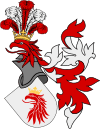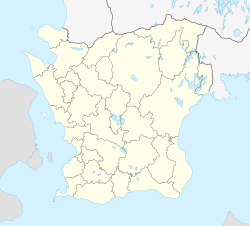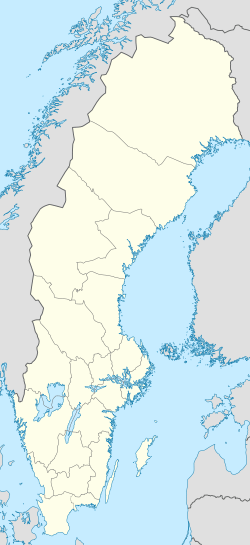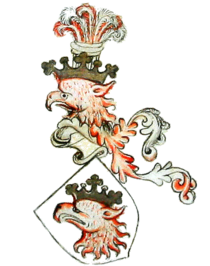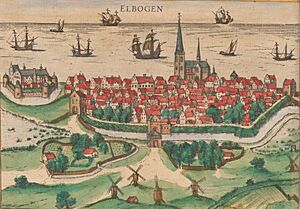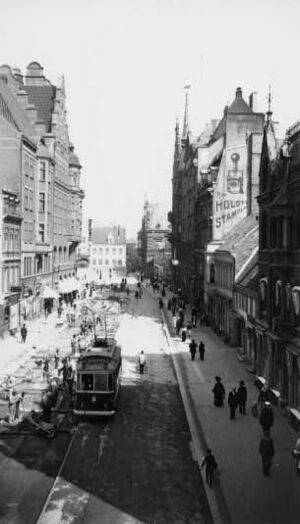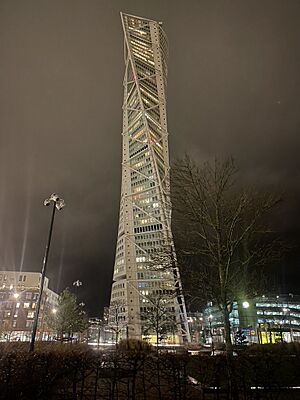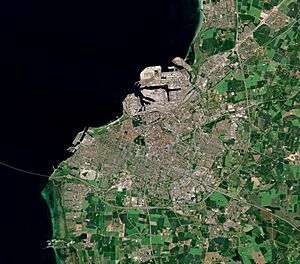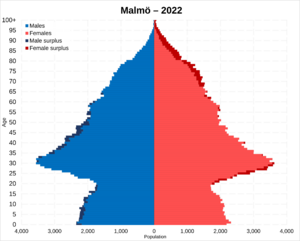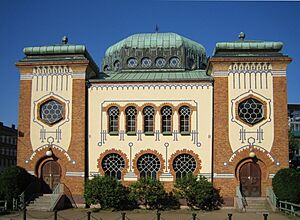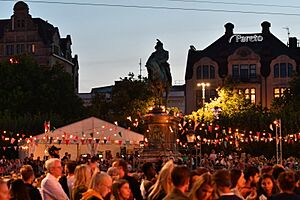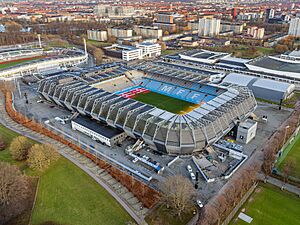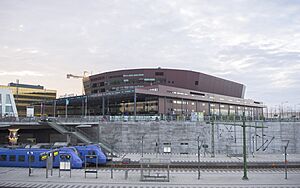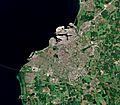Malmö facts for kids
Quick facts for kids
Malmö
|
|||
|---|---|---|---|
|
City
|
|||
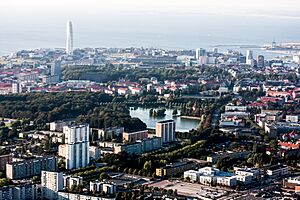 |
|||
|
|||
| Motto(s):
Mångfald, Möten, Möjligheter
(Eng.: Diversity, Meetings, Possibilities) |
|||
| Country | |||
| Province | |||
| County | |||
| Municipality | Malmö Municipality and Burlöv Municipality |
||
| Charter | 13th century | ||
| Area | |||
| • City | 332.6 km2 (128.4 sq mi) | ||
| • Land | 156.9 km2 (60.6 sq mi) | ||
| • Water | 175.8 km2 (67.9 sq mi) | ||
| • Metro | 2,522 km2 (974 sq mi) | ||
| Elevation | 12 m (39 ft) | ||
| Population
(December 2023)
|
|||
| • City | 362,133 | ||
| • Density | 4,049/km2 (10,490/sq mi) | ||
| • Metro | 768,119 | ||
| Demonym(s) | Malmöit | ||
| Time zone | UTC+1 (CET) | ||
| • Summer (DST) | UTC+2 (CEST) | ||
| Postal code |
2xx xx
|
||
| Area code(s) | (+46) 40 | ||
Malmö is a large city in Sweden. It's the third-biggest city in Sweden, after Stockholm and Gothenburg. It's also the sixth-largest city in the Nordic countries. In 2022, about 357,377 people lived in Malmö.
Malmö was once a very industrial city. It had many factories and shipyards. After the year 2000, the city changed a lot. This was helped by the Öresund Bridge being built. New buildings appeared, and companies in technology and science moved in. Many students also came to study at Malmö University.
Today, Malmö is a diverse city with people from many backgrounds. It has many old buildings and beautiful parks. It's also an important business center. Malmö is home to Malmö FF, a famous football club. They have won many national championships.
Malmö has a mild climate, even though it's quite far north. It usually doesn't get too cold in winter. The city is growing fast and is expected to have 500,000 people by 2050.
Contents
- Discovering Malmö's Past
- Malmö's Location and Weather
- Getting Around Malmö
- Malmö's Local Government
- Who Lives in Malmö?
- Malmö's Economy and Jobs
- Tall Buildings in Malmö
- Learning in Malmö
- Malmö's Culture and Arts
- Sports in Malmö
- Malmö's Sister Cities
- Major Events Hosted by Malmö
- Famous People from Malmö
- Images for kids
- See also
Discovering Malmö's Past
Malmö was first mentioned as a city in 1275. It was likely founded as a port for the Archbishop of Lund. Its first name, Malmhaug, meant "Gravel pile".
In the 1400s, Malmö became a very important city in Denmark. About 5,000 people lived there. It was a busy marketplace, especially for herring fishing. In 1437, King Eric of Pomerania gave Malmö its city symbol: a red griffin. This griffin is still a symbol for the whole Skåne region today.
A new fortress, Malmöhus, was built in 1434. It was one of Sweden's most fortified cities, but only Malmöhus remains today.
In the 1500s, Malmö was one of the first cities in Scandinavia to become Protestant.
In 1658, Malmö became part of Sweden after a war with Denmark. There was more fighting later, but Swedish troops successfully defended the city in 1677.
By the early 1700s, Malmö's population dropped due to wars and sickness. It only had about 1,800 people in 1727. The city started growing again after a new harbor was built in 1775. By 1800, there were 4,000 people.
In the 1800s, Malmö became a major industrial center. The Kockums shipyard grew into one of the world's largest. New railways helped Malmö become a hub for textile and machine industries. By 1900, Malmö had 60,000 people. Its population kept growing, reaching 200,000 by 1952.
Malmö in the 20th Century
In 1914, Malmö hosted the Baltic Exhibition, a big event. A large park called Pildammsparken was created for it.
In December 1914, the kings of Sweden, Denmark, and Norway met in Malmö. They agreed to stay neutral during World War I. This meeting helped improve relations between the Nordic countries.
In sports, Malmö is famous for football. Malmö FF became one of Sweden's best clubs in the 1940s. They have won the Swedish league 23 times. They are also the only Nordic club to reach the final of the European Cup.
Malmö's Modern Transformation
By 1971, Malmö's population reached its highest point yet, with 265,000 people. But in the mid-1970s, Sweden faced an economic downturn. Industries like shipbuilding suffered, leading to job losses in Malmö. The Kockums shipyard, a major employer, closed in 1986. Many families moved to nearby towns. By 1985, Malmö's population had fallen to 225,500.
The city's economy struggled more in the early 1990s. However, Malmö began to rebuild itself as a center for culture and knowledge. The huge Öresund Bridge project started in 1995, connecting Malmö to Copenhagen. Malmö University opened in 1998 on the old shipyard land.
The old harbor area was redeveloped. In 2001, a city architecture show called Bo01 was held there. New buildings with great views of the water were built. This area became a popular place to live.
In 2002, the famous Kockums Crane, a symbol of Malmö's industrial past, was moved to South Korea. In 2005, Malmö got a new landmark: Turning Torso. It's the tallest skyscraper in Scandinavia, with a unique twisting design.
Malmö is growing quickly. A new area called Nyhamnen is being planned near the Malmö Central Station. It will have 9,000 new homes and offices. This project is expected to be finished around 2040–2050.
Malmö's Location and Weather
Malmö is located in the southwestern part of Sweden. It's part of the Öresund Region, which includes Copenhagen, Denmark. The Öresund Bridge, opened in 2000, connects Malmö to Copenhagen. The bridge is 8 kilometers (5 miles) long.
Malmö's Climate
Malmö has a mild climate, thanks to the Gulf Stream. Summers are usually mild, with temperatures around 20-23°C (68-73°F). Winters are fairly cold and windy, with temperatures between -3°C and 4°C (27-39°F). It rarely gets colder than -10°C (14°F).
Snowfall mostly happens from December to March. However, snow usually doesn't stay on the ground for long. Some winters even have no snow at all. Malmö gets a moderate amount of rain throughout the year.
Getting Around Malmö

Malmö has great transport links. Trains cross the Öresund Bridge to Copenhagen every 15 minutes. The trip takes about 40 minutes. Some trains also go to other Swedish cities like Stockholm and Gothenburg.
A new underground railway, the City Tunnel, opened in 2010. It runs from Malmö Central Station to Hyllie Station.
Malmö also has its own airport, Malmö Airport. It's mainly used for flights within Sweden and for holiday charters.
The city has a good road system, with major highways connecting it to other parts of Sweden and Europe.
Malmö is very bike-friendly. It has 410 kilometers (255 miles) of bike paths. About 40% of all daily travel in the city is done by bicycle!
Buses in Malmö
Malmö has a large network of buses. These buses help people travel all over the city. There are also regional buses that connect Malmö to other towns in Skåne. The bus network replaced the old tram system in 1973.
Malmö's Harbors
Malmö has two industrial harbors. One is still very active and is the largest port in the Nordic region for importing cars. The city also has two marinas for boats.
Malmö S-Train
A local train line opened in Malmö in 2018. It goes in a circle, stopping at seven stations within the city. This makes it easier for people to travel between different parts of Malmö.
Future Metro Plans
There's a plan for an Öresund Metro. This would be a 22-kilometer (14-mile) tunnel under the Öresund, connecting Malmö to the Copenhagen Metro. If built, the trip between the two cities would take only 20 minutes.
Malmö's Local Government
Malmö Municipality is the local government area that includes Malmö city and its nearby areas. The city of Malmö is the main urban part of this municipality.
In 2010, leaders in Malmö started a project to make the city more socially fair. They wanted to find ways to improve living conditions for everyone, especially those who needed the most help.
Who Lives in Malmö?
Malmö has a young population. Almost half of its residents are under 35 years old.
After a drop in population in the 1970s and 80s, Malmö started growing again. By 2011, the population reached 300,000. In 2017, the city had 316,588 residents.
Malmö is a very diverse city. People from 179 different countries live there. In 2019, about 55.5% of Malmö's population had at least one parent born outside Sweden. Many people have moved to Malmö from the Middle East, Africa, former Yugoslavia, and Denmark.
The Greater Malmö area is one of Sweden's three main metropolitan regions. It includes Malmö and 11 other nearby municipalities. In 2019, over 740,000 people lived in this larger area. Malmö and Lund are the main centers for business and education in this region.
Religions in Malmö
The largest religion in Malmö is Christianity. The Church of Sweden has the most members. There are also several Catholic churches.
Islam is the largest non-Christian religion in Malmö. About 45,000 Muslims live in the city. The Malmö Mosque opened in 1984.
Malmö also has one synagogue, the Malmö Synagogue, for its Jewish community.
Malmö's Economy and Jobs
In the past, Malmö's economy relied on shipbuilding and construction. The main university and related high-tech companies are in Lund, a nearby city.
Malmö faced economic challenges from the mid-1970s. Many jobs were lost, and unemployment was high in the 1990s.
However, Malmö's economy has improved a lot in the last 20 years. The Öresund Bridge helped connect Malmö more closely with Denmark. The opening of Malmö University in 1998 also played a big role.
In 2016, some of the largest private employers in Malmö included:
- Skanska (construction)
- Nobina (transport)
- PostNord (postal services)
- Pågen (bakery)
- IKEA (furniture)
- Nordea (banking)
- Securitas (security services)
Many companies have moved their main offices to Malmö. IKEA, for example, has most of its headquarters functions there. Malmö also has many new start-up companies. About 7 new businesses begin every day in Malmö. The gaming industry is growing especially strong, with companies like Massive Entertainment and King.
Tall Buildings in Malmö
Malmö has several impressive tall buildings:
- Turning Torso, 191 meters (627 feet) tall
- The Point, part of Point Hyllie, 110 meters (361 feet) tall
- St. Peter's Church, Malmö, 96 meters (315 feet) tall
- Malmö Live, 87 meters (285 feet) tall
- Kronprinsen, 82 meters (269 feet) tall
- Hotel Triangeln, 69 meters (226 feet) tall
Learning in Malmö
Malmö is home to Malmö University, which opened in 1998. It's the ninth-largest university in Sweden, with 24,000 students.
Some parts of the famous Lund University are also in Malmö. These include:
- Malmö Art Academy
- Malmö Academy of Music
- Malmö Theatre Academy
The United Nations World Maritime University is also located in Malmö. It trains people from around the world in maritime (sea-related) affairs.
Malmö's Culture and Arts
Movies and TV Shows
Malmö has been featured in films and TV. The movie Raven's End (1963) showed Malmö in the 1930s. The TV series The Bridge (Bron) is set in both Malmö and Copenhagen, connected by the Öresund Bridge.
Theatre and Music
Malmö has a rich theatre scene. The Malmö Municipal Theatre was founded in 1944. It offered plays, opera, musicals, and ballet. Today, it's split into different groups, including the Malmö Operan, which performs operas and musicals.
Malmö is also known for its music. Many famous musicians have played here. The band The Cardigans started in Malmö.
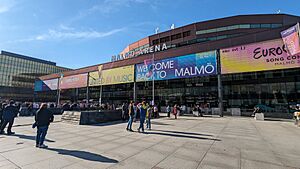
Malmö has hosted the Eurovision Song Contest three times: in 1992, 2013, and 2024. It's the only city that isn't a capital to host it so many times.
The Big Slap is a music festival held every year in Pildammsparken. In 2022, Justin Bieber performed there, which was the biggest concert in Malmö's history.
Museums to Explore
Moderna Museet Malmö opened in 2009. It's part of the National Museum of Modern Art and shows modern and contemporary art.
Malmö Museum is a local museum with exhibitions on technology, shipping, nature, and history. It also has an aquarium and an art museum. Malmöhus Castle is part of this museum.
Malmö Konsthall is one of Europe's largest exhibition halls for modern art. It opened in 1975.
Malmö's Architecture
Malmö's oldest building is St. Peter's Church, built in the early 1300s. It's a beautiful example of Brick Gothic style. Another old building, Tunneln, also dates back to around 1300.
Many of Malmö's oldest buildings were built between 1300 and 1600. They show a strong Danish influence.
In the mid-1800s, Malmö started to expand again. Many buildings from this time are made of stone and brick. You can also see Art Nouveau buildings from the early 1900s, like the Malmö synagogue.
In the 1960s, many new apartments were built around the city. More recently, since the late 1990s, Malmö has seen new and exciting architecture. The Västra hamnen (Western Harbor) area, once industrial, has been rebuilt into a modern neighborhood. It features the Turning Torso, a 190-meter (623-foot) tall skyscraper with a twisting design. It's now a famous landmark.
The newest addition is Malmö Live (2015), a building with a hotel, concert hall, and conference center.
Other Places to Visit
Ribersborg beach, often called Ribban, is a man-made beach southwest of the harbor. It's a popular spot for swimming, even though Malmö's climate is cool. It has an old open-air bath from the 1890s.
The boardwalk at the Western Harbor, called Scaniaparken and Daniaparken, is a favorite place to hang out in summer. It's popular with students and often hosts outdoor parties.
Annual Events in Malmö
Every August, the Malmöfestivalen takes over the city streets. It's a festival with different foods and events.
Malmö hosts several film festivals:
- BUFF International Film Festival for children and young people (March).
- Nordisk Panorama Film Festival for short and documentary films from Nordic countries (September).
- Malmö Arab Film Festival (MAFF), the largest Arabic film festival in Europe.
The Conference is an international event held in Malmö. Speakers from around the world share ideas. The Nordic Game conference also takes place in Malmö, attracting game developers.
Malmö also hosts many other events for its diverse communities, including religious and cultural celebrations.
Malmö's Media
Sydsvenskan is Malmö's largest daily newspaper, founded in 1870. There are also free newspapers about entertainment, music, and fashion. Many local radio and TV stations are based in the Malmö area.
Sports in Malmö
Football Fun
Malmö is famous for its football teams. Malmö FF is a top-level team that has won the Swedish league many times. In 1979, they reached the final of the European Cup, a huge achievement for a Swedish club. Famous players like Zlatan Ibrahimović started their careers at Malmö FF.
Another team, IFK Malmö, also played in Sweden's top league for about 20 years.
FC Rosengård is a top women's football team. They have won the league many times. The famous Brazilian player Marta played for FC Rosengård.
Malmö Stadion hosted games during the 1958 FIFA World Cup.
Other Sports to Watch
Malmö has many other sports teams.
Ice Hockey
The ice hockey team Malmö Redhawks is very popular. They won two Swedish championships in the 1990s.
Handball
HK Malmö is a first-division handball team that draws many fans.
Rugby
The Rugby union team, Malmö RC, has won 6 national championships. They have teams for men, women, and juniors.
Gaelic Football
Gaelic football is also played in Malmö. The men's team, Malmö G.A.A., has won the Scandinavian Championships twice.
More Sports
Other popular sports in Malmö include baseball, American football, and Australian rules football. Individual sports like badminton, athletics, martial arts, and boxing are also popular. Basketball teams like Malbas are also in the city.
Malmö's Sister Cities
Malmö has special connections with these cities around the world:
- Port Adelaide Enfield, Australia
- Stralsund, Germany
- Szczecin, Poland
- Tallinn, Estonia
- Tangshan, China
- Vaasa, Finland
- Varna, Bulgaria
Major Events Hosted by Malmö
| Venue | Event |
|---|---|
| Malmö Stadion | FIFA World Cup 1958 UEFA Euro 1992 |
| Baltic Hall | Table Tennis European Championships 1964 IHF World Men's Handball Championships 1967 Davis Cup 1996 Men's World Floorball Championships 2006 European Women's Handball Championships 2006 |
| Malmö Isstadion | Eurovision Song Contest 1992 European Figure Skating Championships 2003 World Junior Ice Hockey Championships 2014 |
| Eleda Stadion | UEFA European Under-21 Football Championships 2009 |
| Malmö Arena | World Men's Handball Championships 2011 Eurovision Song Contest 2013 Eurovision Song Contest 2024 |
Famous People from Malmö
Images for kids
See also
 In Spanish: Malmö para niños
In Spanish: Malmö para niños



